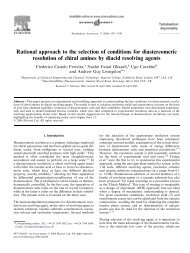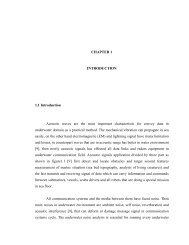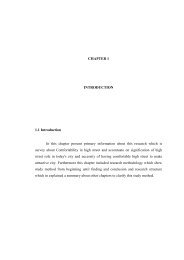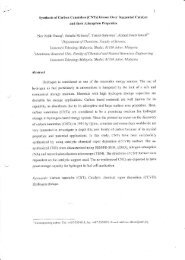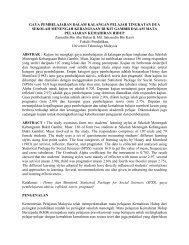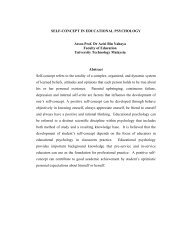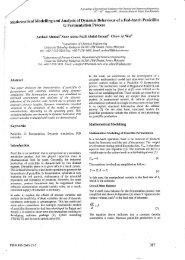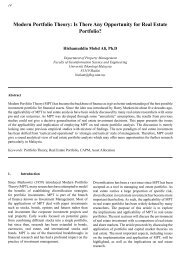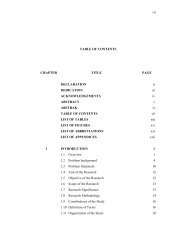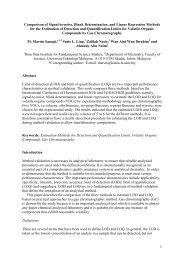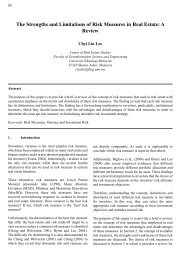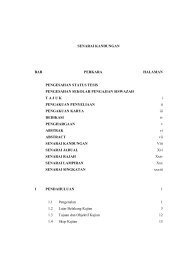CHAPTER 1
CHAPTER 1
CHAPTER 1
Create successful ePaper yourself
Turn your PDF publications into a flip-book with our unique Google optimized e-Paper software.
<strong>CHAPTER</strong> 1<br />
INTRODUCTION<br />
VOT 78004
1.1 Study Background<br />
<strong>CHAPTER</strong> I<br />
INTRODUCTION<br />
Travel is essentially about people and places, the places that one<br />
group people leave, visit and pass through, the other groups who make their<br />
trip possible and those they are encounter along the way. According to Pearce<br />
(1995), in a more technical sense, tourism may be thought of as the<br />
relationship and phenomena arising out of the journeys and temporary stays<br />
of people travelling primarily for leisure or recreational purposes.<br />
The spatial interaction arising out of the tourists’ movement from<br />
origin to destination has not been examined explicitly in much of the<br />
geographical literature on tourism. The majority of geographical, and other,<br />
studies have been concerned with only one part of the system, usually with<br />
the destination, as typified by many ideographic studies which have appeared<br />
since 1960s (Pearce,1995).<br />
An understanding of tourist flow, the spatial pattern of tourist<br />
movement between destination and within destination can help tourism policy<br />
makers, geographers, and the tourism industry itself provide better services<br />
and facilities to cater the needs of the tourist. Further, an understanding of the<br />
factors that affect the tourist movement such as distance decay, market<br />
access, time availability and socio-demographic characteristic can help the<br />
1
industry to determine the optimum location of tourism attractions. (Bob<br />
McKercher, Alan Lew, 2005).<br />
This study will examine the temporal-spatial relationship that exists<br />
between tourism generating areas and destinations. The second part of the<br />
chapter will look into the theoretical perspective of tourist flow and its<br />
movement pattern. The data and information gathered will be analyzed in the<br />
third and fourth part of this chapter. Itineraries model will be developed using<br />
the spatial movement of tourist that have been identified. Finally, conclusion<br />
will be done in the final chapter.<br />
Bandar Gua Musang, which located at the southern part of Kelantan is<br />
chosen as the case study of this research. The town is chosen as it is the main<br />
entrance from major towns in Malaysia to the east coast.<br />
From the result of the findings in the study that have been done,<br />
Gua Musang could benefit from being more aware of its role and its<br />
relationship with other tourism destinations that travelers visit before and<br />
after their arrival.<br />
1.2 Research Statement<br />
The study of tourist movements is important for several reasons. For<br />
those at a destination it is vital to know the origins of the visitors. By<br />
knowing where the market comes from, marketing plan can be drawn up to<br />
reach potential travellers. By studying the geographic characteristics of<br />
existing tourists, it may be possible to identify additional untapped market<br />
areas.<br />
1.3 Study Goal<br />
The goal of this study is to identify the tourist movement patterns and<br />
to summarise the major influences on such movements.<br />
2
1.4 Study Objectives<br />
The main objectives of the study are:-<br />
i. To identify the travel patterns and tourist flows in Bandar Gua<br />
Musang.<br />
ii. To identify the factors that influence tourist movements in the study<br />
area.<br />
iii. To propose travel itineraries that will help to enhance the tourism<br />
industry in the study area.<br />
iv. To identify the most critically needed infrastructure for the purposes<br />
of facilitating the tourist.<br />
1.5 Scope of Study<br />
The scope the study is divided into four main areas. The following are<br />
the areas covered in this study:-<br />
1.5.1 Literature Review<br />
The literature focused on the theoretical perspectives of elements such<br />
as tourist flow, what is meant by travel destination and its type and also the<br />
concept of travel itineraries.<br />
1.5.2 Analysis of Tourist Movement<br />
The analysis of tourist movement will involve the use of Trip Index<br />
where in this model, they generally assume that the majority of people will<br />
take the shortest or otherwise most-efficient route possible from their point of<br />
origin to their destination (Meyer and Miller 1984).<br />
3
1.5.3 Analysis of Tourist Behaviour<br />
The analysis of tourist behaviour is aimed at identifying the type of<br />
tourist, their expectations and trip motivation during their visit to Gua<br />
Musang. The purpose of this analysis is to identify the different market<br />
segment, present travel pattern and willingness to travel. The aspects that will<br />
be analysed are as follows:<br />
Tourist Motivation<br />
Tourist Typology<br />
Tourist Expectation<br />
1.5.4 Tourism Infrastructure in Study Area<br />
observation.<br />
The tourism infrastructure in the study are will be evaluated through<br />
1.6 Study Methodology<br />
The research will be carried out in four stages as follows (Please refer<br />
Study Flow Chart):-<br />
i. Preliminary Stage<br />
The first stage (Phase I) of the study is the preliminary Stage which<br />
comprises the formulation of goal and objectives, literature review<br />
and questionnaires design.<br />
ii. Data Collection<br />
The second stage (Phase II) is the data collection stage involving the<br />
collection of primary and secondary data, Primary data were-collected<br />
by way of a tourist movement survey while secondary data were<br />
gathered from previous studies, reports and official publications.<br />
4
iii. Analysis<br />
The third stage (Phase III) is the analysis that makes to identify the<br />
tourist movement pattern and factors that influence such movement.<br />
The tourist movement analysis will use the Trip Index while the<br />
tourist behaviour analysis will look into the type of tourist, their<br />
expectations and trip motivation during their visit to Gua Musang<br />
iv. Recommendation<br />
Finally, the recommendation stage (Phase IV) is the development of<br />
practical recommendations that can improve the tourist experience,<br />
level of service and facilities catering for Bandar Gua Musang. Trip<br />
itenararies will be proposed<br />
1.7 Significance of the Study<br />
The study will be useful in several ways. It related to government<br />
agencies such as MOTOUR, MTPN Kelantan, Tourism Malaysia and<br />
KESEDAR, the findings and recommendations will be useful in guiding<br />
tourism product development as well as strategic marketing.<br />
In addition, the study will also benefit small scale tourism enterprises<br />
within the district by encouraging more visitations to surrounding/remote<br />
areas. Finally, it will help consolidate the role of Gua Musang in Kelantan<br />
Southern Region as the main gateway to major tourism destination in the east<br />
coast corridor.<br />
5
1.8 Study Area<br />
Gua Musang is a town and territory (jajahan) in Kelantan, Malaysia. It<br />
is the largest district in Kelantan. Gua Musang is administered by the Gua<br />
Musang District Council. Gua Musang district is bordered by the state of<br />
Pahang to the south, Terengganu to the east, Perak to the west and the<br />
Kelantanese districts of Kuala Krai and Jeli to the north. It is a small railway<br />
town about 160 kilometers south of Kuala Krai.<br />
Gua Musang literally means "Cave of the Fox". On the eastern side of<br />
this town stands Bukit Gua Musang, a barren hill of rocks and deceptive<br />
stone-steps running 105 meters high. It stands in a commanding position, with<br />
a huge cave running into its interior and is about meters away from the other<br />
green tree-covered hills. From a distance, this hill looks like a stone pillar<br />
with a big crack which nearly splits it vertically into two equal halves.<br />
Between the hill and the town, there runs a railway track.<br />
Gua Musang is the northern gateway to Taman Negara (National<br />
Park), which is situated in the southeastern part of Gua Musang district. The<br />
untouched tropical rainforest in Taman Negara is among the oldest in the<br />
world. It is well known for its biodiversity and is home to many endangered<br />
species of animals and plants.<br />
Gua Musang is surrounded by limestone hills and caves, which have<br />
become popular with cavers and rock climbers. The small village of Merapoh<br />
in Pahang which is just south of Gua Musang serves as a popular starting<br />
point for those who want to scale Gunung Tahan. Another interesting place to<br />
visit in Gua Musang is a Buddhist temple in Pulai, which is purportedly 400<br />
years old. Nenggiri River is a favourite among those who enjoy river rafting.<br />
There is also a rafting race, called Nenggiri Challenge. Archaeological sites<br />
can be found in caves, such as Gua Cha, Chawan and Jaya, which are situated<br />
along the river.<br />
6
Stage 1: Preliminary Stage<br />
- TRAVEL ITINERARIES<br />
- TRAVEL GATEWAY<br />
- TRANSPORTATION HUB<br />
TOURIST<br />
MOVEMENTS<br />
Stage 2: Data Collection<br />
Stage 3: Analysis & Synthesis<br />
PRIMARY<br />
Tourist Behaviour<br />
Stage 4: Recommendations<br />
INVENTORY<br />
INTERVIEW<br />
OBSERVATION<br />
QUESTIONNAIRE<br />
VERIFYING<br />
TOURIST MOVEMENT<br />
MODEL<br />
Figure 1.1: Study Flow Chart<br />
GOAL<br />
OBJECTIVES<br />
LITERATURE REVIEW<br />
- DESTINATION<br />
CHARACTERISTICS<br />
SCOPE OF STUDY<br />
TOURIST<br />
BEHAVIOUR<br />
DATA COLLECTION<br />
ANALYSIS<br />
SYNTHESIS<br />
RECOMMENDATIONS<br />
SECONDARY<br />
7<br />
TRIP INDEX<br />
REPORTS RELATED<br />
ACADEMIC REFERENCES<br />
GUIDE BOOKS<br />
Tourist Behaviour<br />
TOURISM<br />
INFRASTRUCTURE<br />
TOURISM<br />
INFRASTRUCTURE
to Ipoh town<br />
PERAK<br />
Map 1.1: Location of Study Area<br />
THAILAND<br />
Jeli<br />
JELI<br />
TANAH<br />
MERAH<br />
GUA MUSANG<br />
TUMPAT<br />
Pasir<br />
Tumpat<br />
Mas KOTA BHARU<br />
PASIR MAS<br />
BACHOK<br />
Tanah<br />
Merah<br />
Machang<br />
MACHANG<br />
KUALA KRAI<br />
to Pahang<br />
PASIR PUTEH<br />
Bachok<br />
SOUTH<br />
CHINA<br />
SEA<br />
to Kuala<br />
Terengganu<br />
TERENGGANU<br />
Not to scale<br />
8



